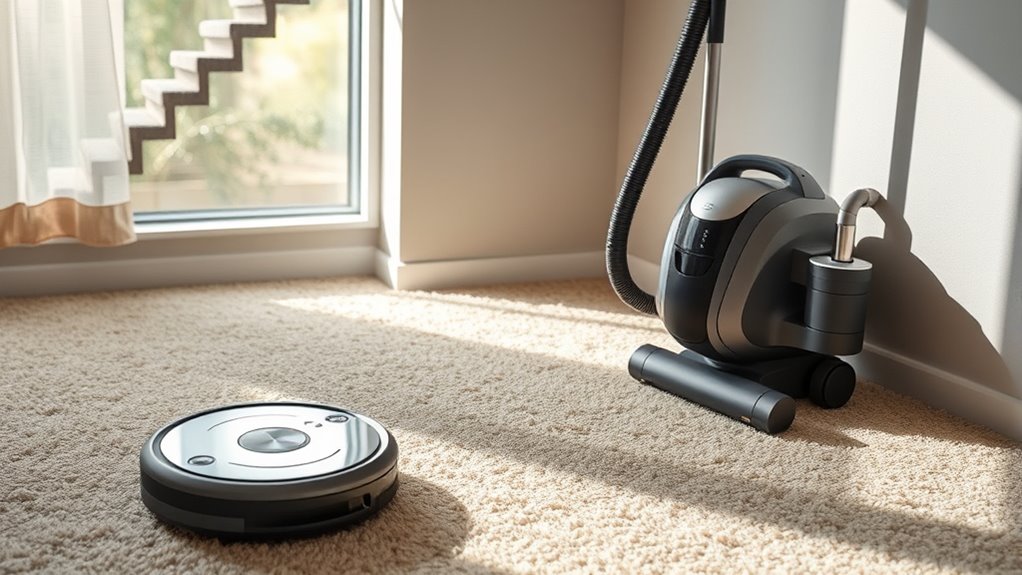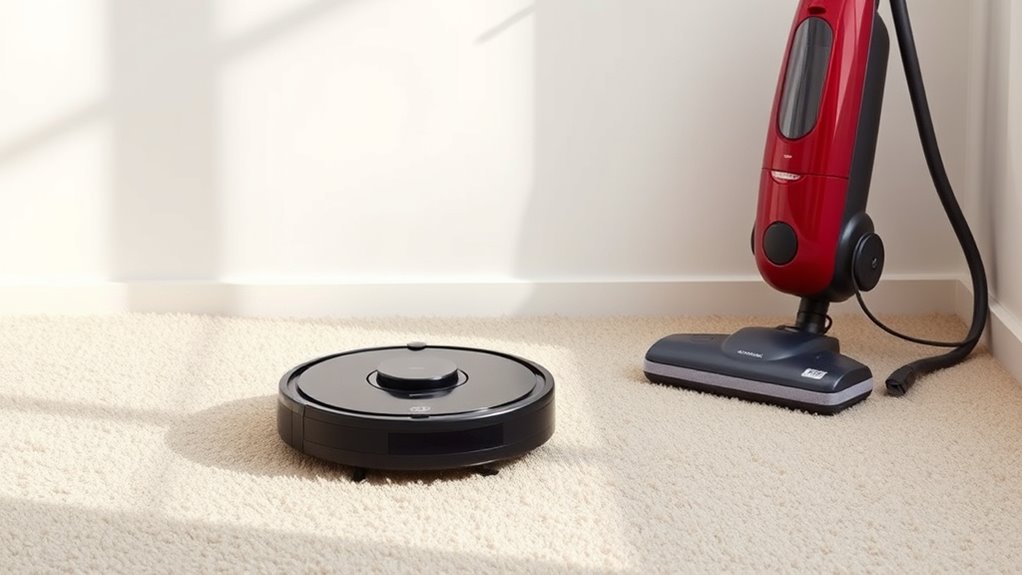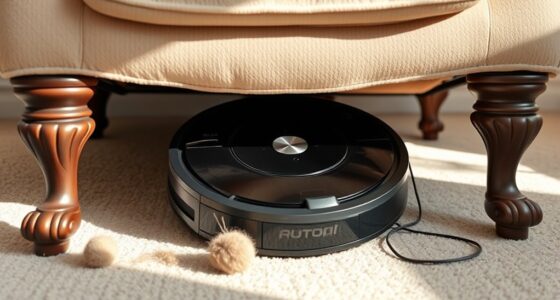If you want to save the most time, robot vacuums are better since they can be scheduled to clean automatically, operate quietly, and require less maintenance. They handle routine cleaning without your involvement, freeing up your day. Traditional vacuums, on the other hand, need manual operation and regular upkeep, taking more time and effort. To discover how each option fits your lifestyle, explore the details behind their features and benefits.
Key Takeaways
- Robot vacuums can be scheduled to clean automatically, saving time on manual operation.
- Traditional vacuums require active involvement and are less efficient for quick, routine cleaning.
- Robot vacuums have automated maintenance alerts, reducing manual upkeep time.
- They operate quietly, allowing cleaning during busy hours or sleep, saving scheduling effort.
- Traditional vacuums often deliver deeper cleaning but take more time for setup and manual use.

When choosing between robot vacuums and traditional models, understanding their differences can help you make an informed decision. One key aspect to contemplate is how each type fits into your routine, especially regarding maintenance routines and noise levels. Traditional vacuums often require more effort to maintain. You need to regularly check and replace filters, clean brushes, and empty dustbins, which can take several minutes each time. Robot vacuums, on the other hand, typically demand less hands-on maintenance. They usually have self-cleaning brushes and filter replacement indicators, making upkeep more straightforward and less time-consuming. However, occasional manual cleaning of sensors or brushes might still be necessary, especially if you have pets that shed heavily or if the robot gets stuck frequently. Additionally, some robot vacuums feature automated maintenance alerts, helping you stay on top of upkeep without extra effort. Noise levels are another vital factor affecting your daily schedule. Traditional vacuums tend to be louder, often reaching decibel levels that can disturb conversations or even wake sleeping children. If you prefer vacuuming during busy hours or while working from home, the noise can be a significant inconvenience. Robot vacuums are generally quieter, operating at a lower noise level, which allows you to run them while working, watching TV, or even sleeping. This quiet operation can save you the hassle of finding the perfect time for cleaning, as you won’t need to coordinate around loud noise. In terms of saving time, robot vacuums excel because they can be scheduled to clean automatically, often daily or multiple times a week, without your direct involvement. You simply set them up, and they handle the rest, freeing you from manual labor. Traditional vacuums require you to be present, physically pushing and maneuvering the device around your home. This makes them less convenient if you’re busy or dislike vacuuming altogether. While traditional models generally offer more power and thorough cleaning, especially for deep messes, they don’t give you the flexibility and time-saving benefits that robot vacuums do.
Frequently Asked Questions
How Long Do Robot Vacuums Typically Last Before Needing Replacement?
Picture your robot vacuum gliding across your floor, its battery lifespan promising several years of service. Typically, it lasts around 2 to 3 years before needing replacement, depending on usage and maintenance. Replacement frequency varies based on how often you run it and how well you care for the battery. Keep an eye on its performance, and you’ll enjoy worry-free cleaning for a good while before considering a new one.
Are Robot Vacuums Effective on All Floor Types?
You might wonder if robot vacuums work on all floor types. Generally, their flooring compatibility varies; they excel on hard floors and low-pile carpets, offering decent cleaning power. However, thick rugs or high-pile carpets may challenge their effectiveness. To maximize efficiency, check your robot vacuum’s specifications to confirm it’s suitable for your flooring, and adjust settings for ideal cleaning performance.
Do Robot Vacuums Require Wi-Fi or App Connectivity?
They say, “Knowledge is power,” and that’s true with robot vacuums. You don’t always need Wi-Fi or app connectivity for them to work effectively. Many models operate offline, just pressing a button to start cleaning. However, if you want remote control, scheduling, or updates, Wi-Fi requirement and app connectivity become handy. So, it depends on how much convenience you want versus simplicity.
Can Robot Vacuums Clean Under Furniture and Tight Spaces?
You’ll find that robot vacuums excel at furniture accessibility and tight space cleaning. Their slim design and flexible movement allow them to slide under beds and sofas, reaching areas you might miss with traditional vacuums. You don’t have to lift heavy furniture or move items around, saving you time and effort. This makes them ideal for maintaining a clean home effortlessly, especially in hard-to-reach spots.
What Is the Average Noise Level of Robot Vacuums During Operation?
While the gentle hum of robot vacuums might seem like a whisper in your home, their noise levels are actually moderate, typically ranging from 60 to 70 decibels. This sound comparison shows they’re quieter than traditional models, allowing you to carry on with daily tasks without much interruption. You’ll find that their quieter operation offers a peaceful cleaning experience, making them ideal for homes where a calm environment matters.
Conclusion
If you’re aiming to save time, robot vacuums could be your best bet—they clean up to 50% faster than traditional vacuums, according to recent studies. Imagine spending less time on chores and more on what truly matters. While traditional vacuums excel at deep cleaning, robot vacuums offer convenience and efficiency. So, if speed and ease are your priorities, switching might just be the smart move you’ve been looking for.









